University Nursing Case Study: Analyzing Sienna's Health and Care Plan
VerifiedAdded on 2021/06/14
|17
|3890
|116
Case Study
AI Summary
This nursing case study focuses on a 43-year-old patient named Sienna, who presents with a history of hyperthyroidism, recent weight gain, elevated blood pressure, and symptoms of social isolation and depression. The study delves into the medical and nursing diagnoses, exploring the differences between them and the patient's specific health challenges. It identifies potential nursing diagnoses such as social isolation, depression, and obesity, supported by the patient's health data, lifestyle changes, and emotional state. The case study outlines a comprehensive nursing care plan that includes interventions such as dietary recommendations, exercise programs, relaxation techniques, and social support strategies. The plan also addresses the potential long-term health risks, such as the development of obesity and major depressive disorder. Finally, the study emphasizes the importance of patient education, monitoring, and collaboration with healthcare professionals to achieve positive health outcomes. The case study provides a detailed assessment, diagnosis, planning, implementation, evaluation and reflection on the patient's condition and care.
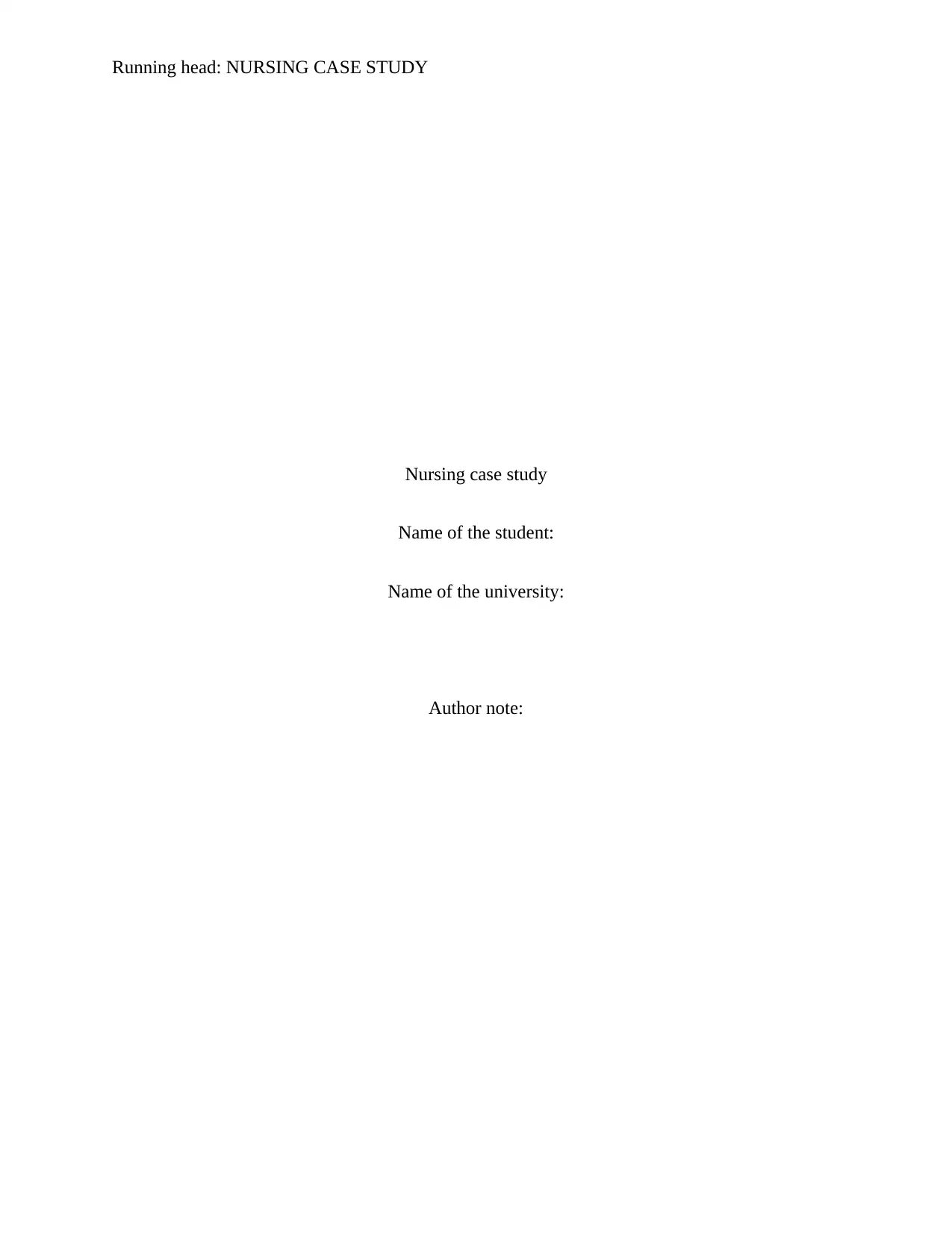
Running head: NURSING CASE STUDY
Nursing case study
Name of the student:
Name of the university:
Author note:
Nursing case study
Name of the student:
Name of the university:
Author note:
Paraphrase This Document
Need a fresh take? Get an instant paraphrase of this document with our AI Paraphraser
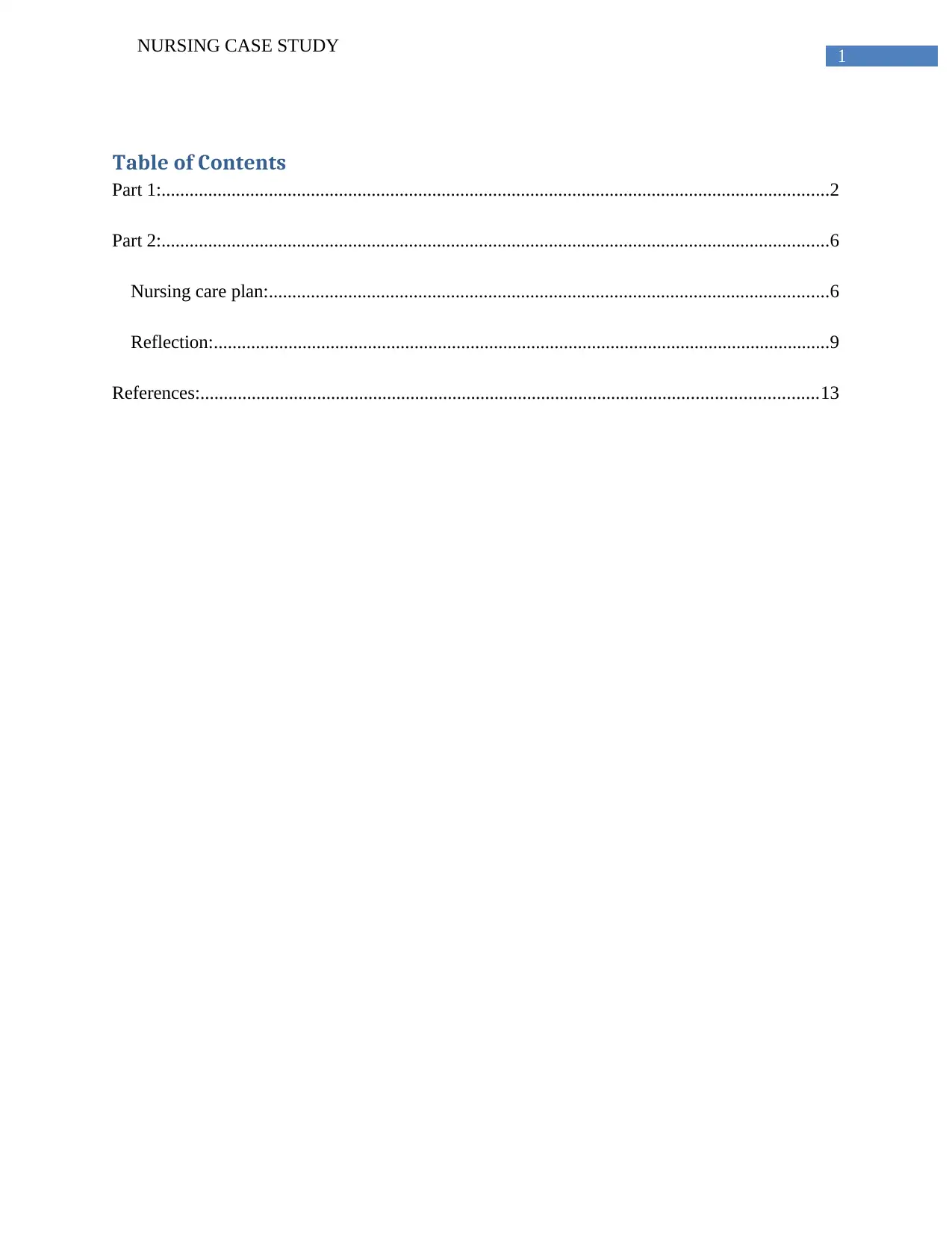
1
NURSING CASE STUDY
Table of Contents
Part 1:...............................................................................................................................................2
Part 2:...............................................................................................................................................6
Nursing care plan:........................................................................................................................6
Reflection:....................................................................................................................................9
References:....................................................................................................................................13
NURSING CASE STUDY
Table of Contents
Part 1:...............................................................................................................................................2
Part 2:...............................................................................................................................................6
Nursing care plan:........................................................................................................................6
Reflection:....................................................................................................................................9
References:....................................................................................................................................13
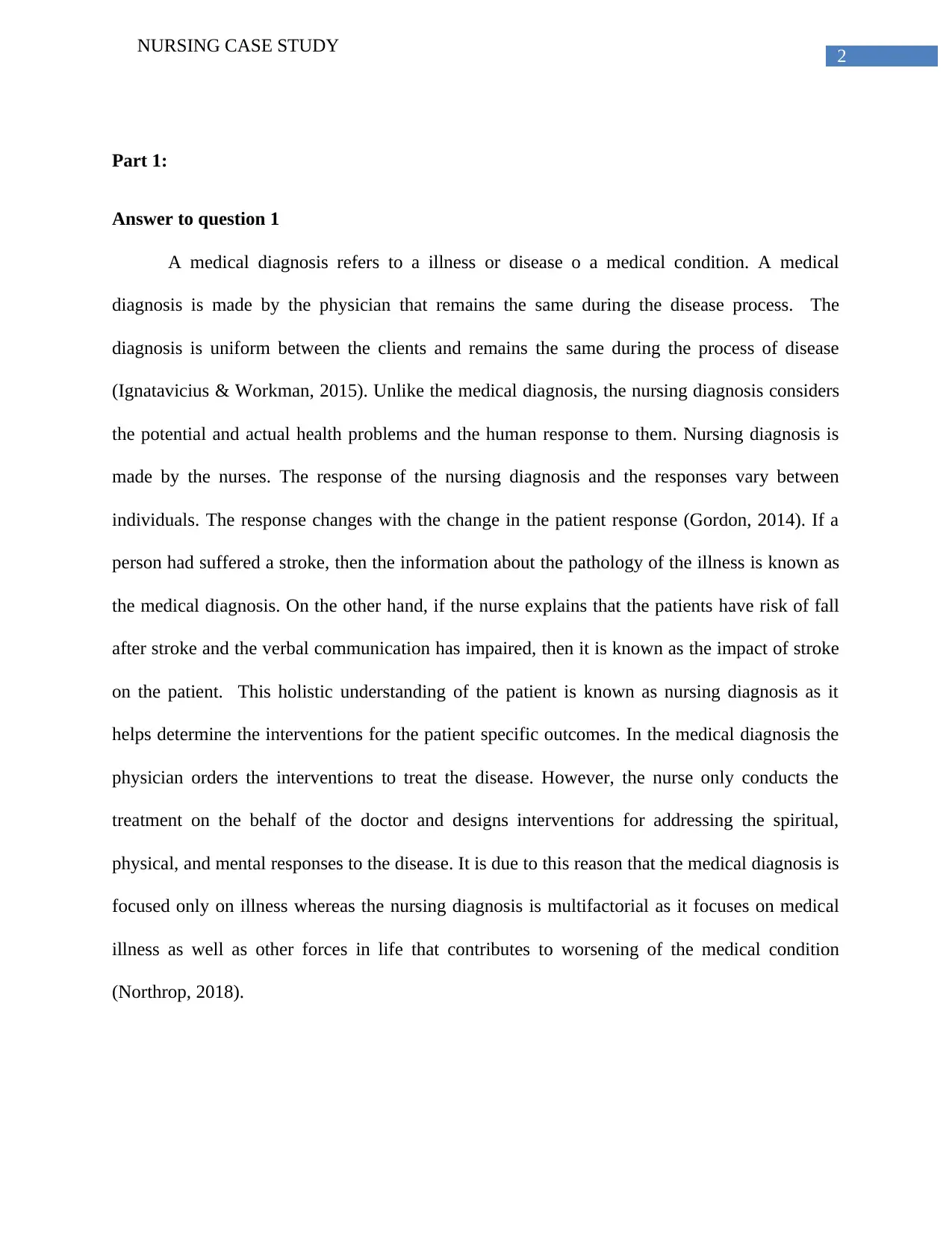
2
NURSING CASE STUDY
Part 1:
Answer to question 1
A medical diagnosis refers to a illness or disease o a medical condition. A medical
diagnosis is made by the physician that remains the same during the disease process. The
diagnosis is uniform between the clients and remains the same during the process of disease
(Ignatavicius & Workman, 2015). Unlike the medical diagnosis, the nursing diagnosis considers
the potential and actual health problems and the human response to them. Nursing diagnosis is
made by the nurses. The response of the nursing diagnosis and the responses vary between
individuals. The response changes with the change in the patient response (Gordon, 2014). If a
person had suffered a stroke, then the information about the pathology of the illness is known as
the medical diagnosis. On the other hand, if the nurse explains that the patients have risk of fall
after stroke and the verbal communication has impaired, then it is known as the impact of stroke
on the patient. This holistic understanding of the patient is known as nursing diagnosis as it
helps determine the interventions for the patient specific outcomes. In the medical diagnosis the
physician orders the interventions to treat the disease. However, the nurse only conducts the
treatment on the behalf of the doctor and designs interventions for addressing the spiritual,
physical, and mental responses to the disease. It is due to this reason that the medical diagnosis is
focused only on illness whereas the nursing diagnosis is multifactorial as it focuses on medical
illness as well as other forces in life that contributes to worsening of the medical condition
(Northrop, 2018).
NURSING CASE STUDY
Part 1:
Answer to question 1
A medical diagnosis refers to a illness or disease o a medical condition. A medical
diagnosis is made by the physician that remains the same during the disease process. The
diagnosis is uniform between the clients and remains the same during the process of disease
(Ignatavicius & Workman, 2015). Unlike the medical diagnosis, the nursing diagnosis considers
the potential and actual health problems and the human response to them. Nursing diagnosis is
made by the nurses. The response of the nursing diagnosis and the responses vary between
individuals. The response changes with the change in the patient response (Gordon, 2014). If a
person had suffered a stroke, then the information about the pathology of the illness is known as
the medical diagnosis. On the other hand, if the nurse explains that the patients have risk of fall
after stroke and the verbal communication has impaired, then it is known as the impact of stroke
on the patient. This holistic understanding of the patient is known as nursing diagnosis as it
helps determine the interventions for the patient specific outcomes. In the medical diagnosis the
physician orders the interventions to treat the disease. However, the nurse only conducts the
treatment on the behalf of the doctor and designs interventions for addressing the spiritual,
physical, and mental responses to the disease. It is due to this reason that the medical diagnosis is
focused only on illness whereas the nursing diagnosis is multifactorial as it focuses on medical
illness as well as other forces in life that contributes to worsening of the medical condition
(Northrop, 2018).
⊘ This is a preview!⊘
Do you want full access?
Subscribe today to unlock all pages.

Trusted by 1+ million students worldwide
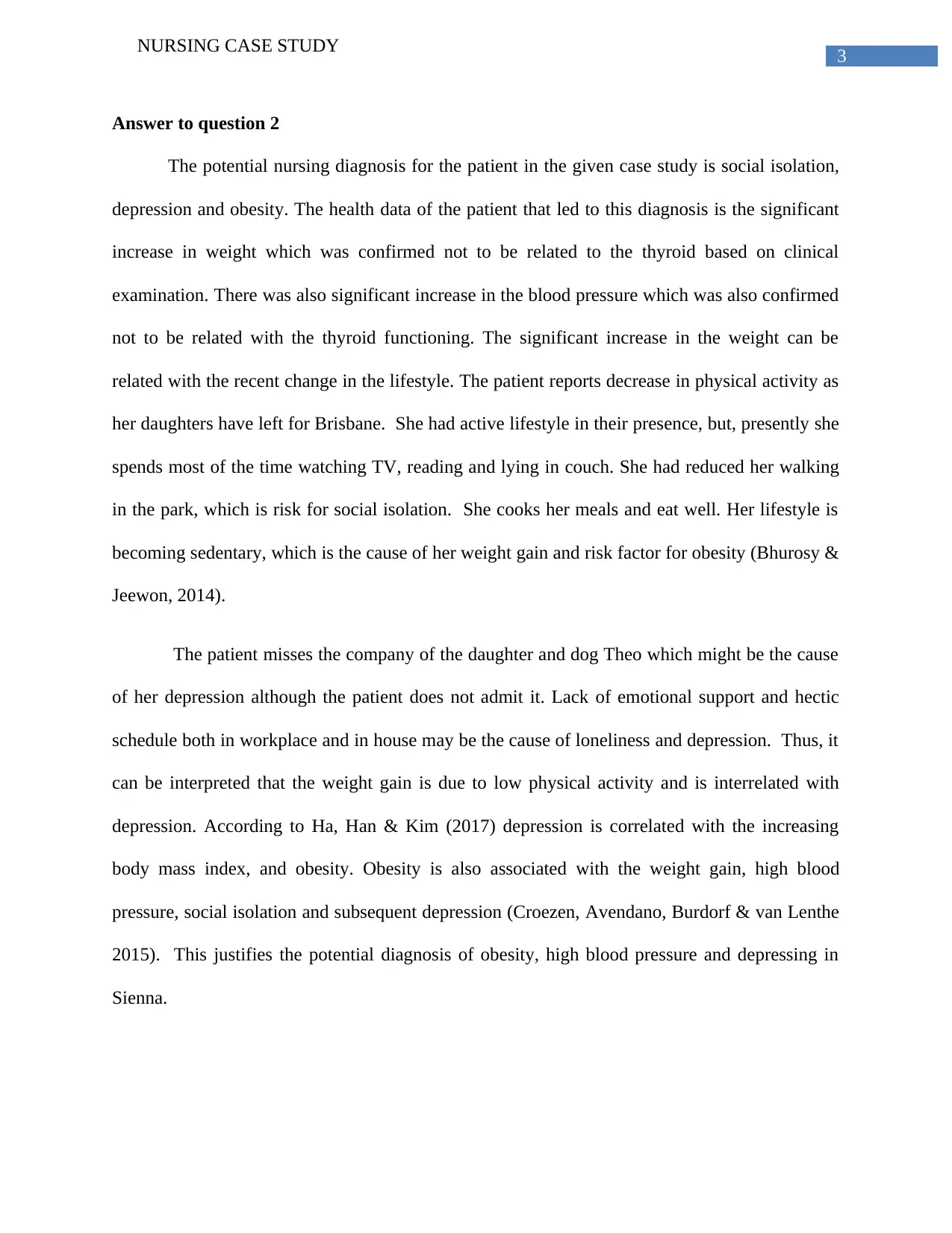
3
NURSING CASE STUDY
Answer to question 2
The potential nursing diagnosis for the patient in the given case study is social isolation,
depression and obesity. The health data of the patient that led to this diagnosis is the significant
increase in weight which was confirmed not to be related to the thyroid based on clinical
examination. There was also significant increase in the blood pressure which was also confirmed
not to be related with the thyroid functioning. The significant increase in the weight can be
related with the recent change in the lifestyle. The patient reports decrease in physical activity as
her daughters have left for Brisbane. She had active lifestyle in their presence, but, presently she
spends most of the time watching TV, reading and lying in couch. She had reduced her walking
in the park, which is risk for social isolation. She cooks her meals and eat well. Her lifestyle is
becoming sedentary, which is the cause of her weight gain and risk factor for obesity (Bhurosy &
Jeewon, 2014).
The patient misses the company of the daughter and dog Theo which might be the cause
of her depression although the patient does not admit it. Lack of emotional support and hectic
schedule both in workplace and in house may be the cause of loneliness and depression. Thus, it
can be interpreted that the weight gain is due to low physical activity and is interrelated with
depression. According to Ha, Han & Kim (2017) depression is correlated with the increasing
body mass index, and obesity. Obesity is also associated with the weight gain, high blood
pressure, social isolation and subsequent depression (Croezen, Avendano, Burdorf & van Lenthe
2015). This justifies the potential diagnosis of obesity, high blood pressure and depressing in
Sienna.
NURSING CASE STUDY
Answer to question 2
The potential nursing diagnosis for the patient in the given case study is social isolation,
depression and obesity. The health data of the patient that led to this diagnosis is the significant
increase in weight which was confirmed not to be related to the thyroid based on clinical
examination. There was also significant increase in the blood pressure which was also confirmed
not to be related with the thyroid functioning. The significant increase in the weight can be
related with the recent change in the lifestyle. The patient reports decrease in physical activity as
her daughters have left for Brisbane. She had active lifestyle in their presence, but, presently she
spends most of the time watching TV, reading and lying in couch. She had reduced her walking
in the park, which is risk for social isolation. She cooks her meals and eat well. Her lifestyle is
becoming sedentary, which is the cause of her weight gain and risk factor for obesity (Bhurosy &
Jeewon, 2014).
The patient misses the company of the daughter and dog Theo which might be the cause
of her depression although the patient does not admit it. Lack of emotional support and hectic
schedule both in workplace and in house may be the cause of loneliness and depression. Thus, it
can be interpreted that the weight gain is due to low physical activity and is interrelated with
depression. According to Ha, Han & Kim (2017) depression is correlated with the increasing
body mass index, and obesity. Obesity is also associated with the weight gain, high blood
pressure, social isolation and subsequent depression (Croezen, Avendano, Burdorf & van Lenthe
2015). This justifies the potential diagnosis of obesity, high blood pressure and depressing in
Sienna.
Paraphrase This Document
Need a fresh take? Get an instant paraphrase of this document with our AI Paraphraser
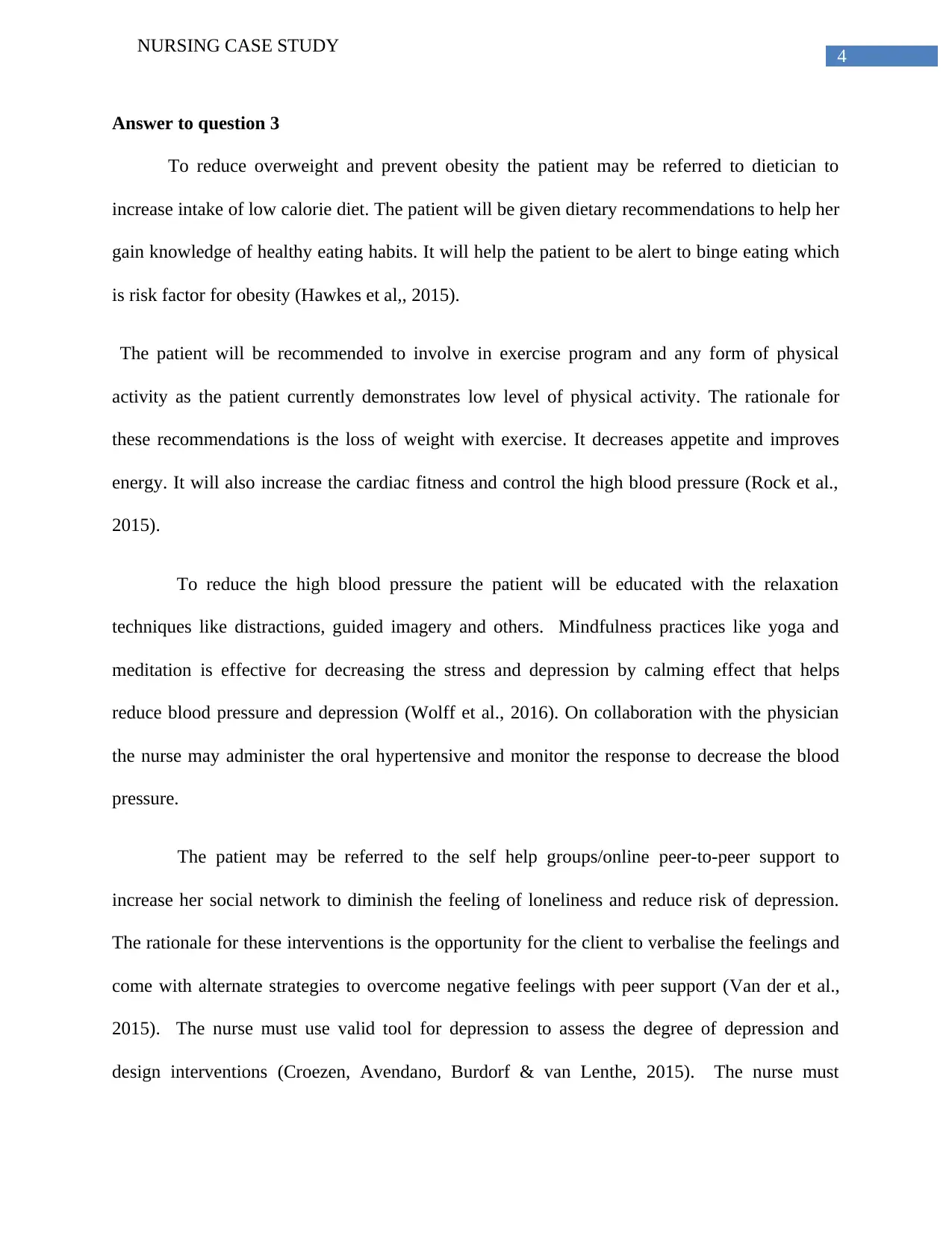
4
NURSING CASE STUDY
Answer to question 3
To reduce overweight and prevent obesity the patient may be referred to dietician to
increase intake of low calorie diet. The patient will be given dietary recommendations to help her
gain knowledge of healthy eating habits. It will help the patient to be alert to binge eating which
is risk factor for obesity (Hawkes et al,, 2015).
The patient will be recommended to involve in exercise program and any form of physical
activity as the patient currently demonstrates low level of physical activity. The rationale for
these recommendations is the loss of weight with exercise. It decreases appetite and improves
energy. It will also increase the cardiac fitness and control the high blood pressure (Rock et al.,
2015).
To reduce the high blood pressure the patient will be educated with the relaxation
techniques like distractions, guided imagery and others. Mindfulness practices like yoga and
meditation is effective for decreasing the stress and depression by calming effect that helps
reduce blood pressure and depression (Wolff et al., 2016). On collaboration with the physician
the nurse may administer the oral hypertensive and monitor the response to decrease the blood
pressure.
The patient may be referred to the self help groups/online peer-to-peer support to
increase her social network to diminish the feeling of loneliness and reduce risk of depression.
The rationale for these interventions is the opportunity for the client to verbalise the feelings and
come with alternate strategies to overcome negative feelings with peer support (Van der et al.,
2015). The nurse must use valid tool for depression to assess the degree of depression and
design interventions (Croezen, Avendano, Burdorf & van Lenthe, 2015). The nurse must
NURSING CASE STUDY
Answer to question 3
To reduce overweight and prevent obesity the patient may be referred to dietician to
increase intake of low calorie diet. The patient will be given dietary recommendations to help her
gain knowledge of healthy eating habits. It will help the patient to be alert to binge eating which
is risk factor for obesity (Hawkes et al,, 2015).
The patient will be recommended to involve in exercise program and any form of physical
activity as the patient currently demonstrates low level of physical activity. The rationale for
these recommendations is the loss of weight with exercise. It decreases appetite and improves
energy. It will also increase the cardiac fitness and control the high blood pressure (Rock et al.,
2015).
To reduce the high blood pressure the patient will be educated with the relaxation
techniques like distractions, guided imagery and others. Mindfulness practices like yoga and
meditation is effective for decreasing the stress and depression by calming effect that helps
reduce blood pressure and depression (Wolff et al., 2016). On collaboration with the physician
the nurse may administer the oral hypertensive and monitor the response to decrease the blood
pressure.
The patient may be referred to the self help groups/online peer-to-peer support to
increase her social network to diminish the feeling of loneliness and reduce risk of depression.
The rationale for these interventions is the opportunity for the client to verbalise the feelings and
come with alternate strategies to overcome negative feelings with peer support (Van der et al.,
2015). The nurse must use valid tool for depression to assess the degree of depression and
design interventions (Croezen, Avendano, Burdorf & van Lenthe, 2015). The nurse must
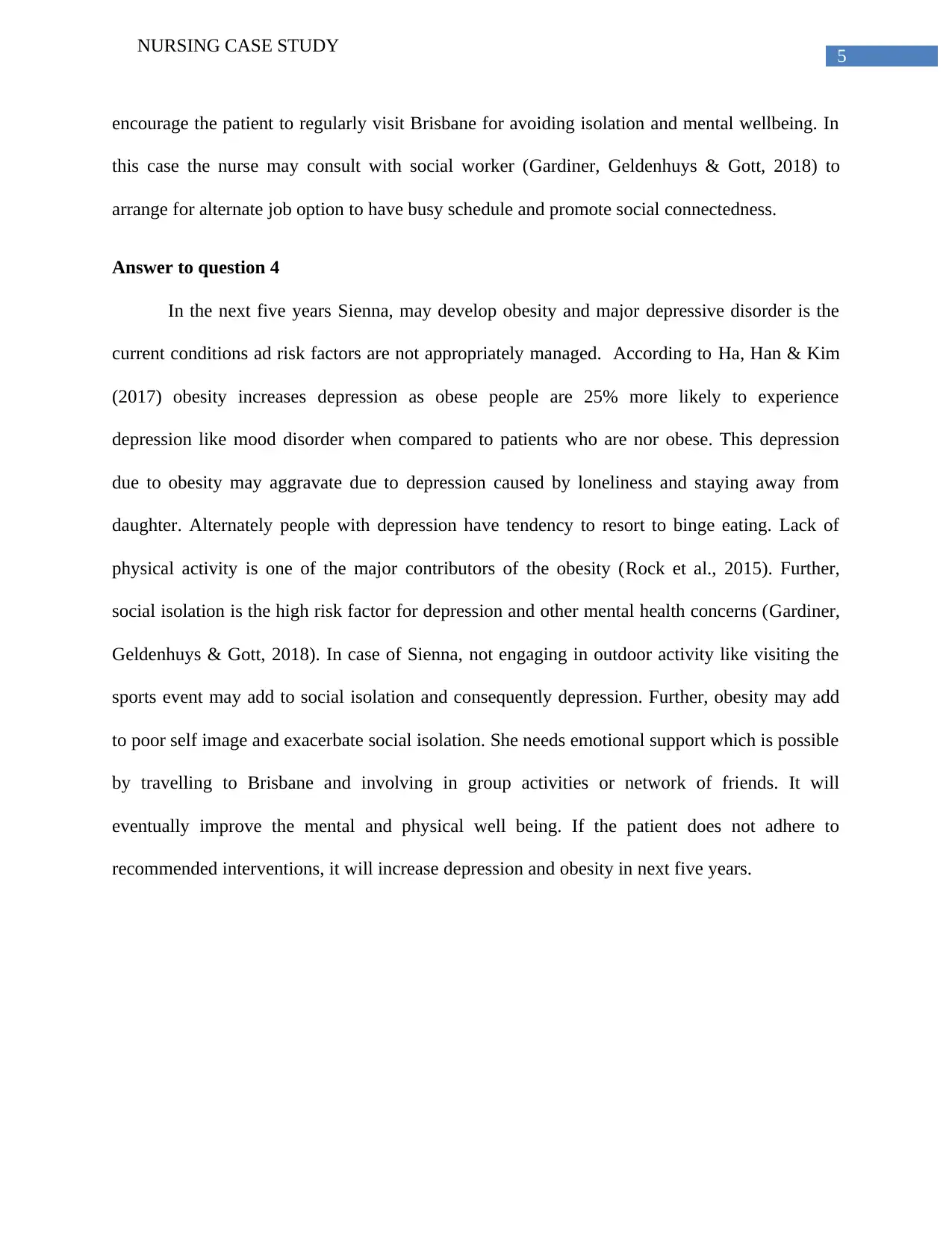
5
NURSING CASE STUDY
encourage the patient to regularly visit Brisbane for avoiding isolation and mental wellbeing. In
this case the nurse may consult with social worker (Gardiner, Geldenhuys & Gott, 2018) to
arrange for alternate job option to have busy schedule and promote social connectedness.
Answer to question 4
In the next five years Sienna, may develop obesity and major depressive disorder is the
current conditions ad risk factors are not appropriately managed. According to Ha, Han & Kim
(2017) obesity increases depression as obese people are 25% more likely to experience
depression like mood disorder when compared to patients who are nor obese. This depression
due to obesity may aggravate due to depression caused by loneliness and staying away from
daughter. Alternately people with depression have tendency to resort to binge eating. Lack of
physical activity is one of the major contributors of the obesity (Rock et al., 2015). Further,
social isolation is the high risk factor for depression and other mental health concerns (Gardiner,
Geldenhuys & Gott, 2018). In case of Sienna, not engaging in outdoor activity like visiting the
sports event may add to social isolation and consequently depression. Further, obesity may add
to poor self image and exacerbate social isolation. She needs emotional support which is possible
by travelling to Brisbane and involving in group activities or network of friends. It will
eventually improve the mental and physical well being. If the patient does not adhere to
recommended interventions, it will increase depression and obesity in next five years.
NURSING CASE STUDY
encourage the patient to regularly visit Brisbane for avoiding isolation and mental wellbeing. In
this case the nurse may consult with social worker (Gardiner, Geldenhuys & Gott, 2018) to
arrange for alternate job option to have busy schedule and promote social connectedness.
Answer to question 4
In the next five years Sienna, may develop obesity and major depressive disorder is the
current conditions ad risk factors are not appropriately managed. According to Ha, Han & Kim
(2017) obesity increases depression as obese people are 25% more likely to experience
depression like mood disorder when compared to patients who are nor obese. This depression
due to obesity may aggravate due to depression caused by loneliness and staying away from
daughter. Alternately people with depression have tendency to resort to binge eating. Lack of
physical activity is one of the major contributors of the obesity (Rock et al., 2015). Further,
social isolation is the high risk factor for depression and other mental health concerns (Gardiner,
Geldenhuys & Gott, 2018). In case of Sienna, not engaging in outdoor activity like visiting the
sports event may add to social isolation and consequently depression. Further, obesity may add
to poor self image and exacerbate social isolation. She needs emotional support which is possible
by travelling to Brisbane and involving in group activities or network of friends. It will
eventually improve the mental and physical well being. If the patient does not adhere to
recommended interventions, it will increase depression and obesity in next five years.
⊘ This is a preview!⊘
Do you want full access?
Subscribe today to unlock all pages.

Trusted by 1+ million students worldwide

6
NURSING CASE STUDY
Part 2:
Nursing care plan:
Assessment:
According to the patient health history the patient has been suffering from
hyperthyroidism and she had a subtotal thyroidectomy surgery. The previous visit with the health
care facility had been focused on increasing weight and high blood pressure facilitated by her
stressful life and the sedentary lifestyle. She had also been taking antihypertensives to reduce her
rapidly rising blood pressure. The patient has now presented in the facility due to the
unconsciousness and fall she had sustained in the workplace.
The vital signs of the patient include BP 118/63, P 72, RR 24, P 36.4, and Wt. 88.9kgm
the patient had been previously instructed to commence on weight reduction plan which the
patient has discontinued and has started gaining weight again. The patient has also stated that due
to both her daughters and their dog being gone, the patient has resorted to feeling quite down,
alone and isolated after over 6 months of not seeing her daughters except for the occasional
facetime or phone call. The patient understands that her sedentary lifestyle will lead to gaining
weight again and will affect her thyroid again but the patient does not know what to do and
where to start again.
Diagnosis:
NURSING CASE STUDY
Part 2:
Nursing care plan:
Assessment:
According to the patient health history the patient has been suffering from
hyperthyroidism and she had a subtotal thyroidectomy surgery. The previous visit with the health
care facility had been focused on increasing weight and high blood pressure facilitated by her
stressful life and the sedentary lifestyle. She had also been taking antihypertensives to reduce her
rapidly rising blood pressure. The patient has now presented in the facility due to the
unconsciousness and fall she had sustained in the workplace.
The vital signs of the patient include BP 118/63, P 72, RR 24, P 36.4, and Wt. 88.9kgm
the patient had been previously instructed to commence on weight reduction plan which the
patient has discontinued and has started gaining weight again. The patient has also stated that due
to both her daughters and their dog being gone, the patient has resorted to feeling quite down,
alone and isolated after over 6 months of not seeing her daughters except for the occasional
facetime or phone call. The patient understands that her sedentary lifestyle will lead to gaining
weight again and will affect her thyroid again but the patient does not know what to do and
where to start again.
Diagnosis:
Paraphrase This Document
Need a fresh take? Get an instant paraphrase of this document with our AI Paraphraser
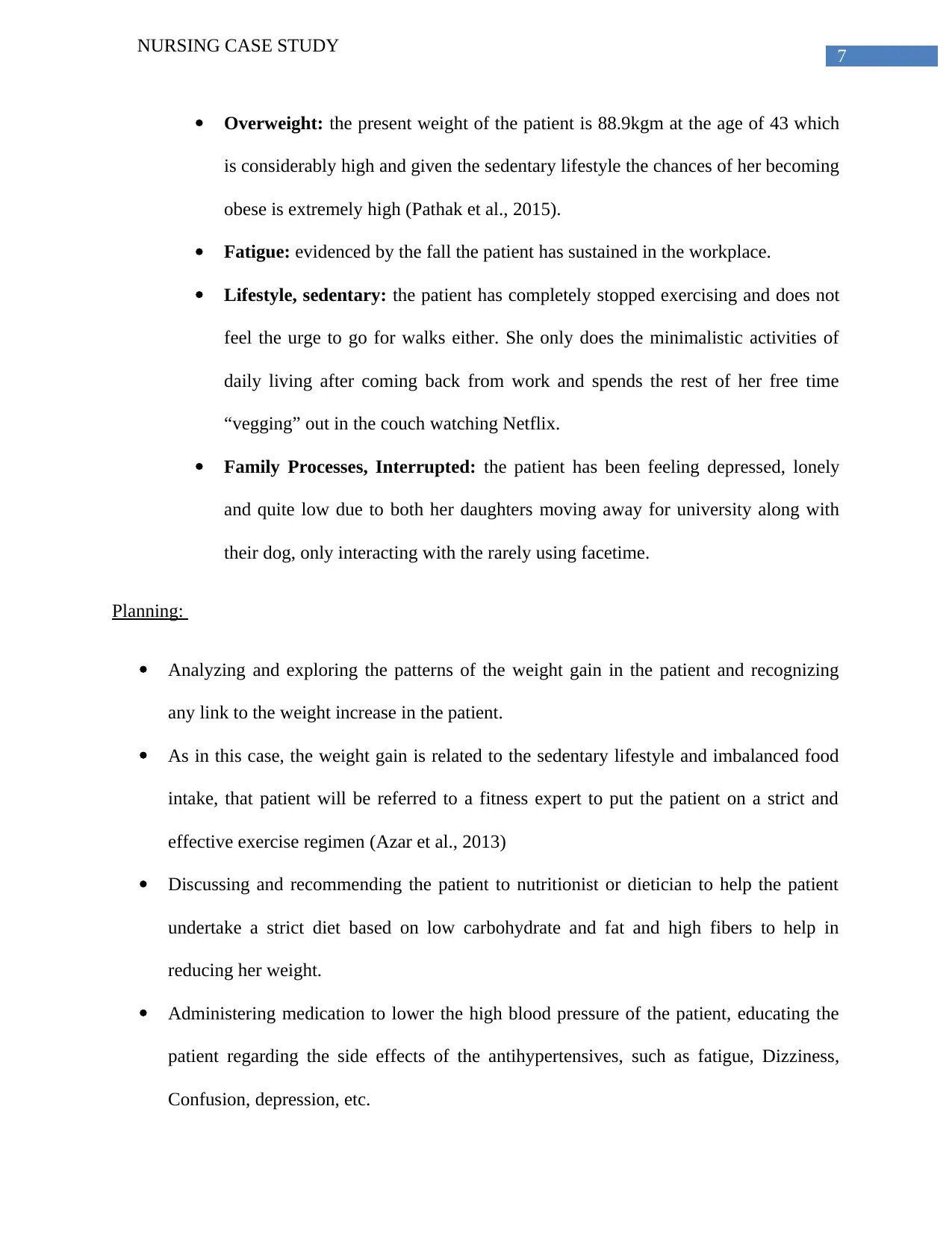
7
NURSING CASE STUDY
Overweight: the present weight of the patient is 88.9kgm at the age of 43 which
is considerably high and given the sedentary lifestyle the chances of her becoming
obese is extremely high (Pathak et al., 2015).
Fatigue: evidenced by the fall the patient has sustained in the workplace.
Lifestyle, sedentary: the patient has completely stopped exercising and does not
feel the urge to go for walks either. She only does the minimalistic activities of
daily living after coming back from work and spends the rest of her free time
“vegging” out in the couch watching Netflix.
Family Processes, Interrupted: the patient has been feeling depressed, lonely
and quite low due to both her daughters moving away for university along with
their dog, only interacting with the rarely using facetime.
Planning:
Analyzing and exploring the patterns of the weight gain in the patient and recognizing
any link to the weight increase in the patient.
As in this case, the weight gain is related to the sedentary lifestyle and imbalanced food
intake, that patient will be referred to a fitness expert to put the patient on a strict and
effective exercise regimen (Azar et al., 2013)
Discussing and recommending the patient to nutritionist or dietician to help the patient
undertake a strict diet based on low carbohydrate and fat and high fibers to help in
reducing her weight.
Administering medication to lower the high blood pressure of the patient, educating the
patient regarding the side effects of the antihypertensives, such as fatigue, Dizziness,
Confusion, depression, etc.
NURSING CASE STUDY
Overweight: the present weight of the patient is 88.9kgm at the age of 43 which
is considerably high and given the sedentary lifestyle the chances of her becoming
obese is extremely high (Pathak et al., 2015).
Fatigue: evidenced by the fall the patient has sustained in the workplace.
Lifestyle, sedentary: the patient has completely stopped exercising and does not
feel the urge to go for walks either. She only does the minimalistic activities of
daily living after coming back from work and spends the rest of her free time
“vegging” out in the couch watching Netflix.
Family Processes, Interrupted: the patient has been feeling depressed, lonely
and quite low due to both her daughters moving away for university along with
their dog, only interacting with the rarely using facetime.
Planning:
Analyzing and exploring the patterns of the weight gain in the patient and recognizing
any link to the weight increase in the patient.
As in this case, the weight gain is related to the sedentary lifestyle and imbalanced food
intake, that patient will be referred to a fitness expert to put the patient on a strict and
effective exercise regimen (Azar et al., 2013)
Discussing and recommending the patient to nutritionist or dietician to help the patient
undertake a strict diet based on low carbohydrate and fat and high fibers to help in
reducing her weight.
Administering medication to lower the high blood pressure of the patient, educating the
patient regarding the side effects of the antihypertensives, such as fatigue, Dizziness,
Confusion, depression, etc.
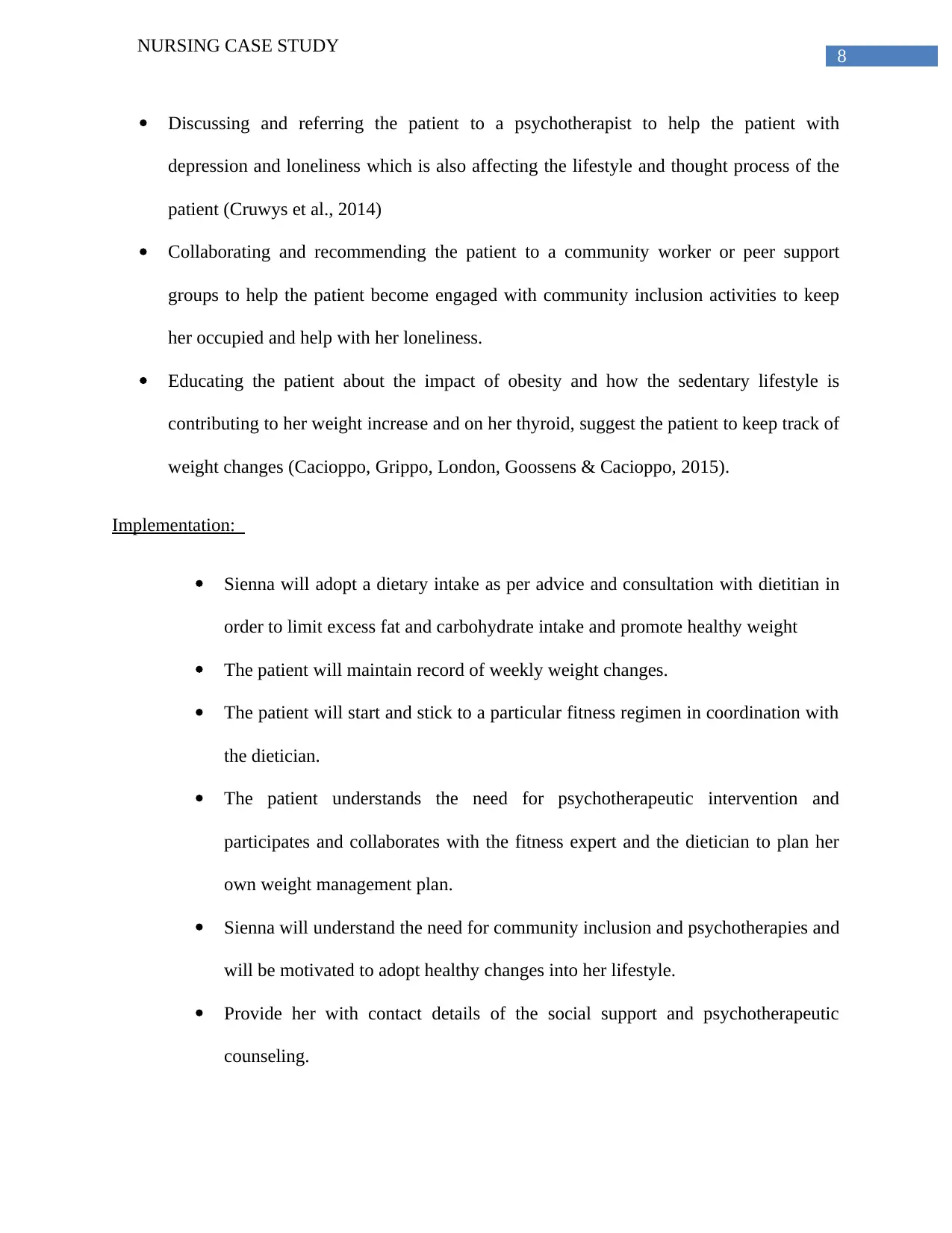
8
NURSING CASE STUDY
Discussing and referring the patient to a psychotherapist to help the patient with
depression and loneliness which is also affecting the lifestyle and thought process of the
patient (Cruwys et al., 2014)
Collaborating and recommending the patient to a community worker or peer support
groups to help the patient become engaged with community inclusion activities to keep
her occupied and help with her loneliness.
Educating the patient about the impact of obesity and how the sedentary lifestyle is
contributing to her weight increase and on her thyroid, suggest the patient to keep track of
weight changes (Cacioppo, Grippo, London, Goossens & Cacioppo, 2015).
Implementation:
Sienna will adopt a dietary intake as per advice and consultation with dietitian in
order to limit excess fat and carbohydrate intake and promote healthy weight
The patient will maintain record of weekly weight changes.
The patient will start and stick to a particular fitness regimen in coordination with
the dietician.
The patient understands the need for psychotherapeutic intervention and
participates and collaborates with the fitness expert and the dietician to plan her
own weight management plan.
Sienna will understand the need for community inclusion and psychotherapies and
will be motivated to adopt healthy changes into her lifestyle.
Provide her with contact details of the social support and psychotherapeutic
counseling.
NURSING CASE STUDY
Discussing and referring the patient to a psychotherapist to help the patient with
depression and loneliness which is also affecting the lifestyle and thought process of the
patient (Cruwys et al., 2014)
Collaborating and recommending the patient to a community worker or peer support
groups to help the patient become engaged with community inclusion activities to keep
her occupied and help with her loneliness.
Educating the patient about the impact of obesity and how the sedentary lifestyle is
contributing to her weight increase and on her thyroid, suggest the patient to keep track of
weight changes (Cacioppo, Grippo, London, Goossens & Cacioppo, 2015).
Implementation:
Sienna will adopt a dietary intake as per advice and consultation with dietitian in
order to limit excess fat and carbohydrate intake and promote healthy weight
The patient will maintain record of weekly weight changes.
The patient will start and stick to a particular fitness regimen in coordination with
the dietician.
The patient understands the need for psychotherapeutic intervention and
participates and collaborates with the fitness expert and the dietician to plan her
own weight management plan.
Sienna will understand the need for community inclusion and psychotherapies and
will be motivated to adopt healthy changes into her lifestyle.
Provide her with contact details of the social support and psychotherapeutic
counseling.
⊘ This is a preview!⊘
Do you want full access?
Subscribe today to unlock all pages.

Trusted by 1+ million students worldwide
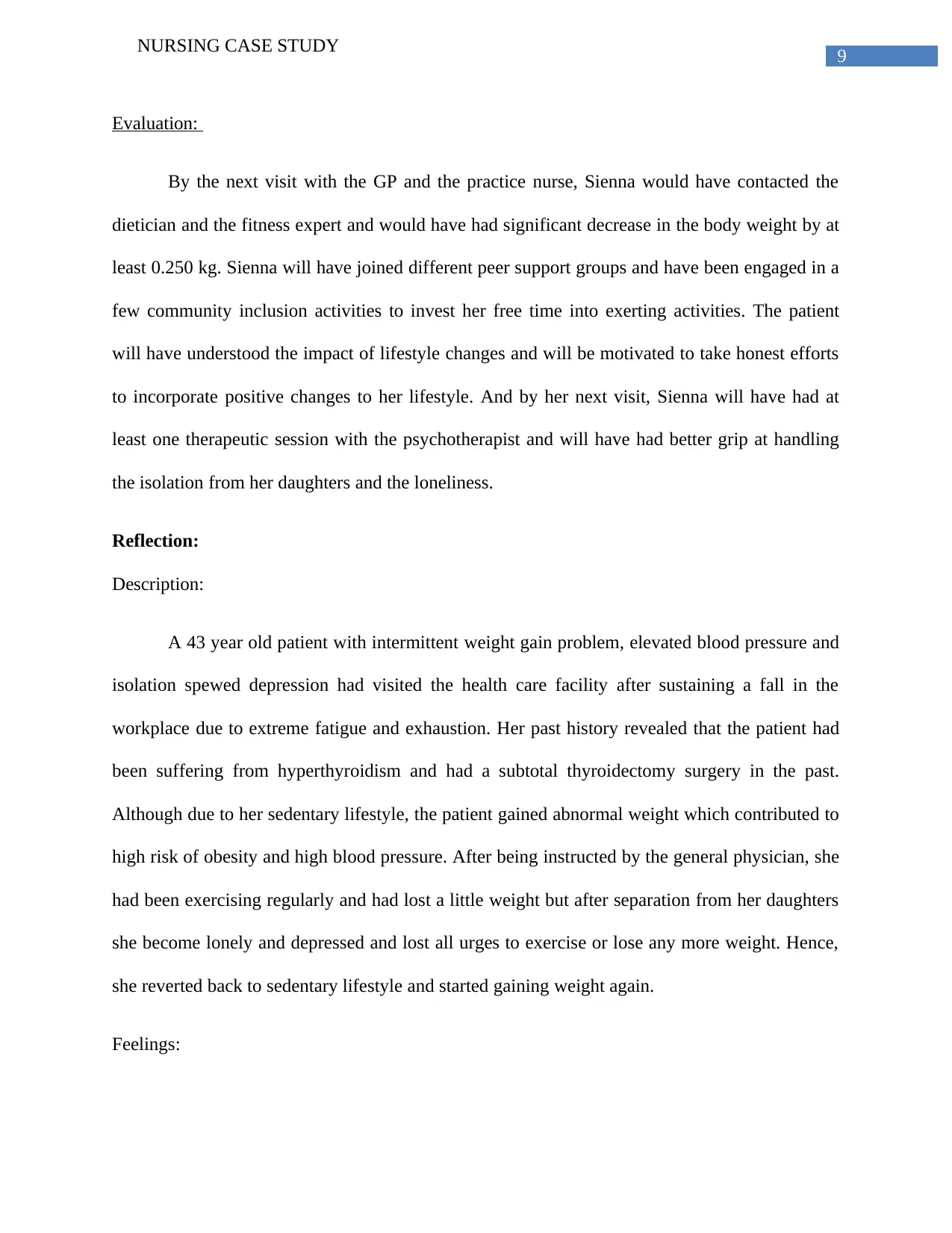
9
NURSING CASE STUDY
Evaluation:
By the next visit with the GP and the practice nurse, Sienna would have contacted the
dietician and the fitness expert and would have had significant decrease in the body weight by at
least 0.250 kg. Sienna will have joined different peer support groups and have been engaged in a
few community inclusion activities to invest her free time into exerting activities. The patient
will have understood the impact of lifestyle changes and will be motivated to take honest efforts
to incorporate positive changes to her lifestyle. And by her next visit, Sienna will have had at
least one therapeutic session with the psychotherapist and will have had better grip at handling
the isolation from her daughters and the loneliness.
Reflection:
Description:
A 43 year old patient with intermittent weight gain problem, elevated blood pressure and
isolation spewed depression had visited the health care facility after sustaining a fall in the
workplace due to extreme fatigue and exhaustion. Her past history revealed that the patient had
been suffering from hyperthyroidism and had a subtotal thyroidectomy surgery in the past.
Although due to her sedentary lifestyle, the patient gained abnormal weight which contributed to
high risk of obesity and high blood pressure. After being instructed by the general physician, she
had been exercising regularly and had lost a little weight but after separation from her daughters
she become lonely and depressed and lost all urges to exercise or lose any more weight. Hence,
she reverted back to sedentary lifestyle and started gaining weight again.
Feelings:
NURSING CASE STUDY
Evaluation:
By the next visit with the GP and the practice nurse, Sienna would have contacted the
dietician and the fitness expert and would have had significant decrease in the body weight by at
least 0.250 kg. Sienna will have joined different peer support groups and have been engaged in a
few community inclusion activities to invest her free time into exerting activities. The patient
will have understood the impact of lifestyle changes and will be motivated to take honest efforts
to incorporate positive changes to her lifestyle. And by her next visit, Sienna will have had at
least one therapeutic session with the psychotherapist and will have had better grip at handling
the isolation from her daughters and the loneliness.
Reflection:
Description:
A 43 year old patient with intermittent weight gain problem, elevated blood pressure and
isolation spewed depression had visited the health care facility after sustaining a fall in the
workplace due to extreme fatigue and exhaustion. Her past history revealed that the patient had
been suffering from hyperthyroidism and had a subtotal thyroidectomy surgery in the past.
Although due to her sedentary lifestyle, the patient gained abnormal weight which contributed to
high risk of obesity and high blood pressure. After being instructed by the general physician, she
had been exercising regularly and had lost a little weight but after separation from her daughters
she become lonely and depressed and lost all urges to exercise or lose any more weight. Hence,
she reverted back to sedentary lifestyle and started gaining weight again.
Feelings:
Paraphrase This Document
Need a fresh take? Get an instant paraphrase of this document with our AI Paraphraser

10
NURSING CASE STUDY
Sienna is a middle aged woman with a fulfilling career and the responsibility of two
young daughters pursuing university medication. After being separated from her daughters, the
patient become very lonely and her daughter’s busy schedules and not being able to meet them
had a detrimental impact on her psyche and she felt quite down, lonely and isolated. Due to the
impact of living alone and isolated, she lost her will to exercise or incorporate any changes to her
lifestyle and reverted back to the sedentary lifestyle. Even though she understood that her weight
gain will negatively impact her thyroid and blood pressure, she felt clueless to what to do and
where to start. Hence her care plan needs to focus on her weight management, support services to
incorporate community inclusion to support with lifestyle change and psychotherapy.
Evaluation:
The care plan will help her make positive changes to reduce her weight effectively by
both taking nutritious and high energy diet targeted for weight loss and regular exercise regimen.
Along with that, the care plan will also address her isolation and onset of depression due to
separation from her daughters. The peer group sessions and community activity will keep her
engaged and will help in reducing the feeling of loneliness and depression. The counseling
session recommended will help in motivating her to adapt changes in lifestyle and live a healthy
life.
Analysis:
The patient had presented with two main health concerns, weight management and onset
of depression with elevated blood pressure and fatigue. From the detailed assessment it was
discovered that her isolation and depression had negatively impacted her will to continue healthy
lifestyle and even though she understood the impact of her going back to her sedentary ways of
NURSING CASE STUDY
Sienna is a middle aged woman with a fulfilling career and the responsibility of two
young daughters pursuing university medication. After being separated from her daughters, the
patient become very lonely and her daughter’s busy schedules and not being able to meet them
had a detrimental impact on her psyche and she felt quite down, lonely and isolated. Due to the
impact of living alone and isolated, she lost her will to exercise or incorporate any changes to her
lifestyle and reverted back to the sedentary lifestyle. Even though she understood that her weight
gain will negatively impact her thyroid and blood pressure, she felt clueless to what to do and
where to start. Hence her care plan needs to focus on her weight management, support services to
incorporate community inclusion to support with lifestyle change and psychotherapy.
Evaluation:
The care plan will help her make positive changes to reduce her weight effectively by
both taking nutritious and high energy diet targeted for weight loss and regular exercise regimen.
Along with that, the care plan will also address her isolation and onset of depression due to
separation from her daughters. The peer group sessions and community activity will keep her
engaged and will help in reducing the feeling of loneliness and depression. The counseling
session recommended will help in motivating her to adapt changes in lifestyle and live a healthy
life.
Analysis:
The patient had presented with two main health concerns, weight management and onset
of depression with elevated blood pressure and fatigue. From the detailed assessment it was
discovered that her isolation and depression had negatively impacted her will to continue healthy
lifestyle and even though she understood the impact of her going back to her sedentary ways of
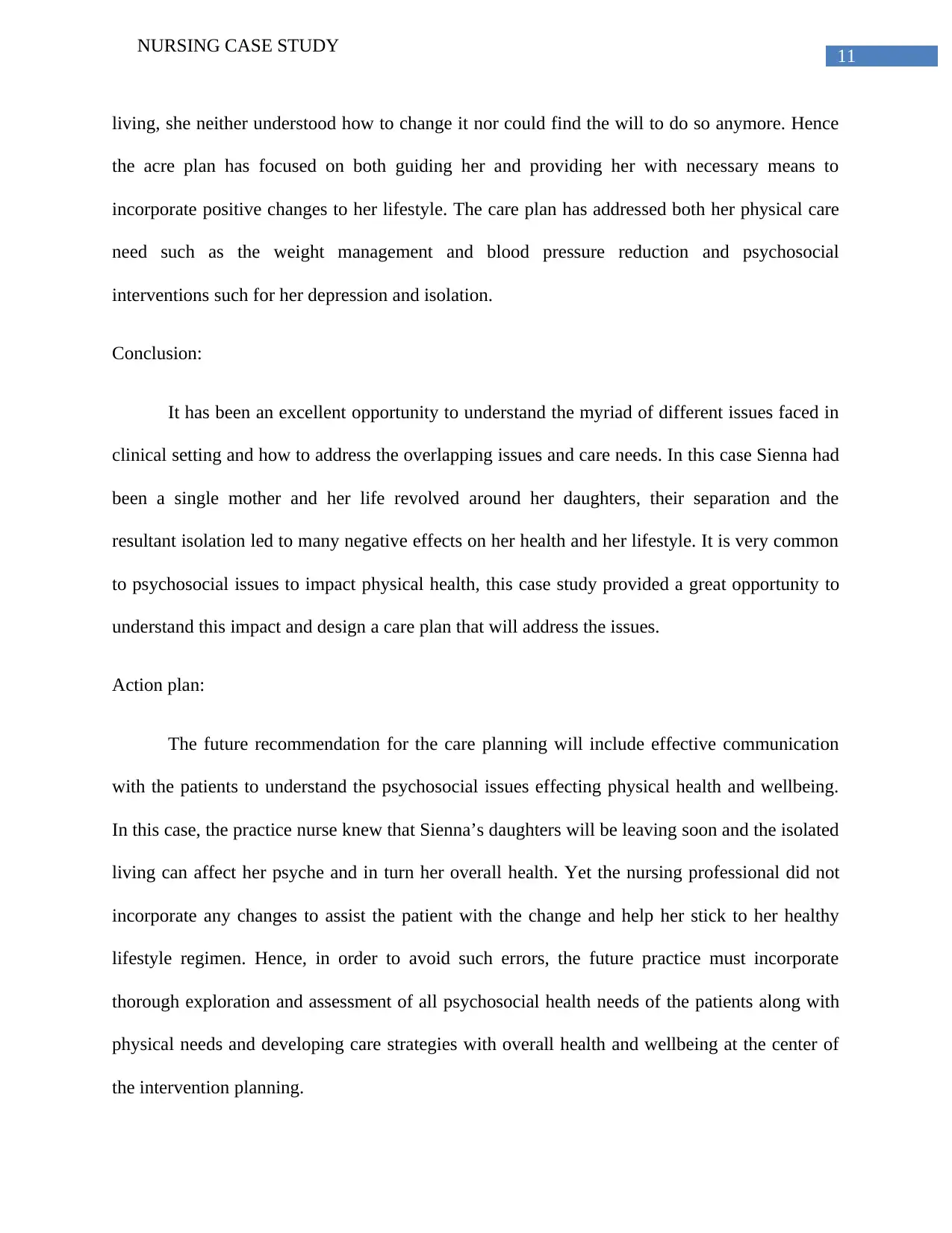
11
NURSING CASE STUDY
living, she neither understood how to change it nor could find the will to do so anymore. Hence
the acre plan has focused on both guiding her and providing her with necessary means to
incorporate positive changes to her lifestyle. The care plan has addressed both her physical care
need such as the weight management and blood pressure reduction and psychosocial
interventions such for her depression and isolation.
Conclusion:
It has been an excellent opportunity to understand the myriad of different issues faced in
clinical setting and how to address the overlapping issues and care needs. In this case Sienna had
been a single mother and her life revolved around her daughters, their separation and the
resultant isolation led to many negative effects on her health and her lifestyle. It is very common
to psychosocial issues to impact physical health, this case study provided a great opportunity to
understand this impact and design a care plan that will address the issues.
Action plan:
The future recommendation for the care planning will include effective communication
with the patients to understand the psychosocial issues effecting physical health and wellbeing.
In this case, the practice nurse knew that Sienna’s daughters will be leaving soon and the isolated
living can affect her psyche and in turn her overall health. Yet the nursing professional did not
incorporate any changes to assist the patient with the change and help her stick to her healthy
lifestyle regimen. Hence, in order to avoid such errors, the future practice must incorporate
thorough exploration and assessment of all psychosocial health needs of the patients along with
physical needs and developing care strategies with overall health and wellbeing at the center of
the intervention planning.
NURSING CASE STUDY
living, she neither understood how to change it nor could find the will to do so anymore. Hence
the acre plan has focused on both guiding her and providing her with necessary means to
incorporate positive changes to her lifestyle. The care plan has addressed both her physical care
need such as the weight management and blood pressure reduction and psychosocial
interventions such for her depression and isolation.
Conclusion:
It has been an excellent opportunity to understand the myriad of different issues faced in
clinical setting and how to address the overlapping issues and care needs. In this case Sienna had
been a single mother and her life revolved around her daughters, their separation and the
resultant isolation led to many negative effects on her health and her lifestyle. It is very common
to psychosocial issues to impact physical health, this case study provided a great opportunity to
understand this impact and design a care plan that will address the issues.
Action plan:
The future recommendation for the care planning will include effective communication
with the patients to understand the psychosocial issues effecting physical health and wellbeing.
In this case, the practice nurse knew that Sienna’s daughters will be leaving soon and the isolated
living can affect her psyche and in turn her overall health. Yet the nursing professional did not
incorporate any changes to assist the patient with the change and help her stick to her healthy
lifestyle regimen. Hence, in order to avoid such errors, the future practice must incorporate
thorough exploration and assessment of all psychosocial health needs of the patients along with
physical needs and developing care strategies with overall health and wellbeing at the center of
the intervention planning.
⊘ This is a preview!⊘
Do you want full access?
Subscribe today to unlock all pages.

Trusted by 1+ million students worldwide
1 out of 17
Related Documents
Your All-in-One AI-Powered Toolkit for Academic Success.
+13062052269
info@desklib.com
Available 24*7 on WhatsApp / Email
![[object Object]](/_next/static/media/star-bottom.7253800d.svg)
Unlock your academic potential
Copyright © 2020–2026 A2Z Services. All Rights Reserved. Developed and managed by ZUCOL.





